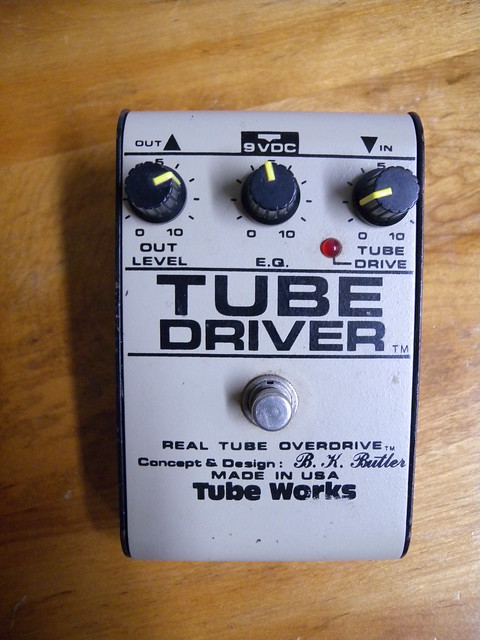
- BK BUTLER TUBE WORKS TUBE DRIVER SCHEMATIC MOD
- BK BUTLER TUBE WORKS TUBE DRIVER SCHEMATIC DRIVER
- BK BUTLER TUBE WORKS TUBE DRIVER SCHEMATIC SERIES
BK BUTLER TUBE WORKS TUBE DRIVER SCHEMATIC DRIVER
Surprisingly, the Tube Driver has experienced a bit of a nomadic life: This pedal has been around long enough to have accrued multiple pages worth of history so I'll condense it down for you. I finally got around to trying one out and here is what I found:

Being hand-built for most of its life and priced accordingly, it was also one of the very first boutique pedals. During its long life the Tube Driver has appeared in many forms. This is a pedal that has been around for over thirty years and has become a long-standing favorite amongst some of the most elite players in the business for its smooth distortion and boost capabilities. Have you ever had one of those guitar items that you always wanted to try but never seemed to get around to? The BK Butler 911 Tube Driver has been one of those items for me.
BK BUTLER TUBE WORKS TUBE DRIVER SCHEMATIC MOD
GUITAR TOOLBOX BASICS: The BK Butler 911 Tube Driver with Bias Mod You also need to watch out for places where there is supposed to be a through board connection and for a few places where connections must be made in the proper sequence so that the pads don't get buried (I recall one that is under the tube).BK Butler Tube Driver Stepping up to a Classic It took me a few tries before I got a board I was satisfied with. Getting the two sides in proper alignment was not easy. Put this pedal in a metal enclosure and mess up the wiring and you could have a real shock hazard on your hands. If you haven't worked with line voltage you should be very careful and perhaps seek some advice from a friend with some experience. I have hand my fingers in tube amps and a ton of other electronic gear so item (1) did not concern me. Two major issues are (1) working with line voltage and (2) the double sided pcb. There are many good ideas and modifications presented along the way that you might want to learn about.Īs mentioned in the original posting in that thread this is not a beginner project. Read through the entire thread before you dive in. Here's a link to a long thread on another forum. At 150mA 0.15A the 10 ohm resistor loses 1.5V, which is probably a good value for many situations.Build it, measure voltage AT the heater, and fudge this resistor to stay above 11 and below 14V.
BK BUTLER TUBE WORKS TUBE DRIVER SCHEMATIC SERIES
(At 15V the heater life would be similar to a light-bulb, a thousand hours.) The heater is just a hot resistor, and the easiest way to waste-off some voltage is with a series resistor. At 14V or more I would consider reducing the voltage. 13V or 13.5V is not worth fretting about. Since you won't have a custom exact-right transformer (values of 200mA, 500mA, and 660mA are mentioned here), the transformer is UNDER-loaded and you wind up a little above 12.6VAC at actual load.

Actually a "12V" trannie is wound for 14V-16V no-load, and sags near 12V at maximum load. > the heater supply does pass through a 10 ohm (power not given) resistor. Notice that with over-kill, a heavier guitar or a mistake in computing the opamp or tube load does not mean a bent hook or a burnt transformer. Yes, but, it's like: you need an 1/8-inch hook to hang your guitar, but there's a 1/4-inch hook in your spare-screws bin, so that's what you use. > Probably major overkill for the job at hand. The 500mA may be easier to find and/or cheaper. The 12V 200mA part is in excess of the required 172mA and will be fine. You can hardly buy a transformer this small. Total AC current is 150mA + 22mA or 172mA. Then multiply by 1.6-1.8 to account for AC-DC conversion stress. To get back to the transformer AC rating: first double this to account for doubler-action, 13mA. Do we care? Let's see how bad things look.ģ6V (total DC suply: 5mA opamps, 1.5mA tubes, 6.5mA total. Then the maximum current is 36V/47K or 0.75mA. Exact analysis is hit-or-miss, but worst-case analysis is easy. Also one sheet shows cathode bias (common to both cascaded tubes, an unstable affair), the other is zero bias one shows 68K plate resistors and the other shows 47K. The datasheet is NO help because we are so far away from "typical" voltages. The DC supply is 12V AC doubled to roughly +/-18V DC, 36V total.

Heater is nominal 12.6V 0.15A, and may be AC.


 0 kommentar(er)
0 kommentar(er)
